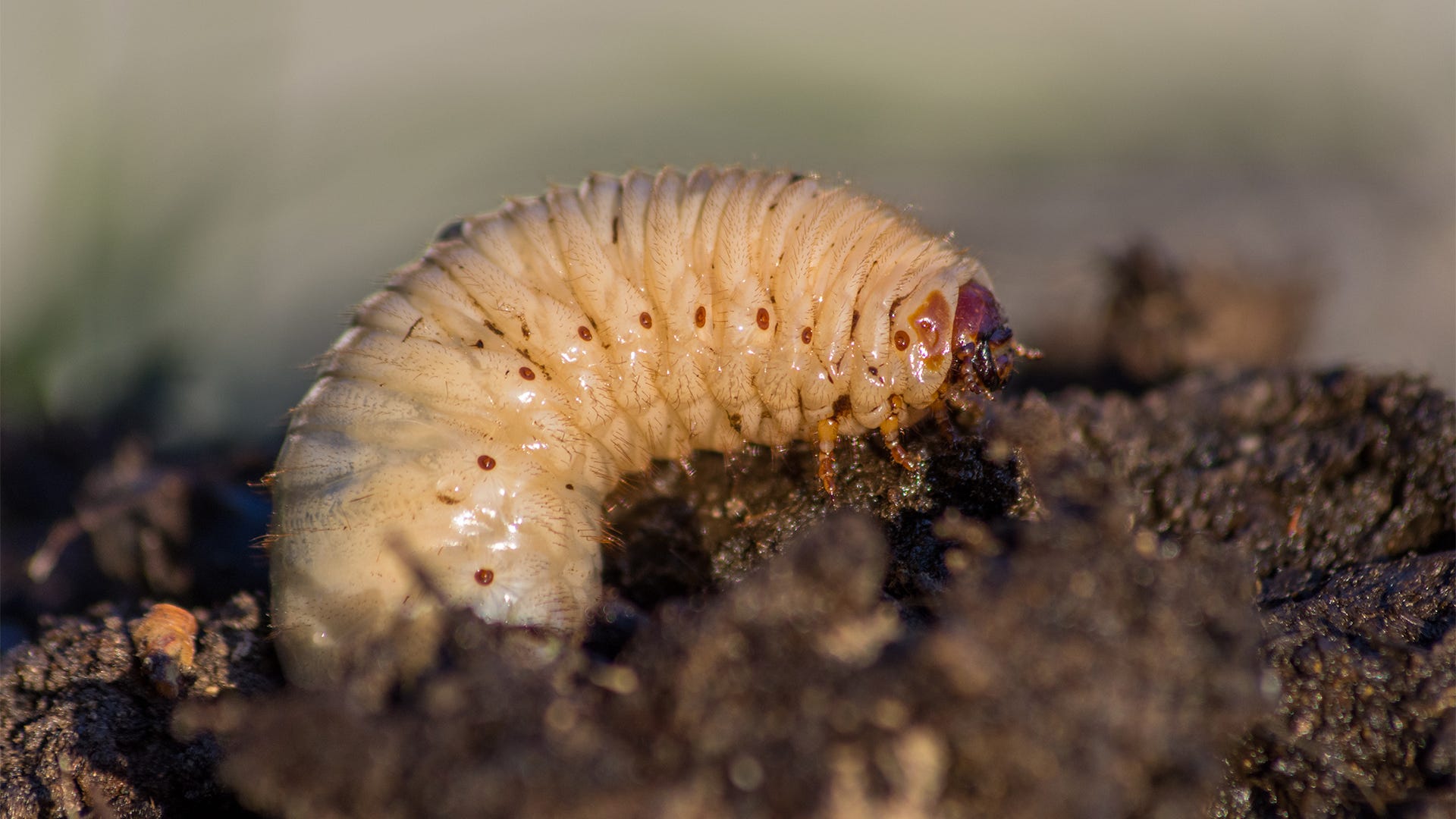
Lawn grubs — these wormy little pests can turn your carpet of green into a brown-splotched mess! Here’s what you need to know to get rid of them and keep them from coming back.

Who
Lawn grubs are the larvae of a group of beetles known as “scarabs.” The grubs that plague lawns in the United States most commonly come from masked chafer and Japanese beetles. The larvae are plump and grayish-white with a brown head and six legs. Depending on the species and their age, grubs may be from one-half to 1 inch long. When you see grubs, they are typically lying on their sides, curled up into a C-shaped position.
When
In July and early August, female beetles lay as many as 60 eggs each in the soil, just below the root zone of your grass. The eggs hatch about two weeks later. The grubs that emerge from the eggs begin feeding on grass roots right away and continue until frost. When winter arrives, the grubs burrow deeper into the soil, down to about 6 inches. As the soil warms up in spring, grubs move back up to where the grass roots are growing and resume feeding. In mid to late spring, the grubs pupate and re-emerge as adult beetles.
Where
Grubs are lawn pests throughout North America. They do not infest every lawn, but wherever they do they can cause significant, noticeable damage. Adult masked chafer beetles do not eat at all during their brief lives, which is not uncommon for many types of insects. Japanese beetles, however, are destructive pests of roses, raspberries, grapes, and other home garden plants. When adult beetles of all kinds are ready to lay eggs, they’re attracted to lawns that get full sun, have loose soil, and are consistently moist— conditions that are also ideal for growing grass.
What
Above the ground, you won’t see lawn grubs themselves, but you can see evidence of their work: irregularly shaped patches of dead and dying grass. Dig up and peel back grass along the border where a brown section meets the green. You want to dig about 4 inches deep, just below the grass’s root zone. If you see 10 or more grubs in 1 square foot that you’ve uncovered, you can blame them for the problem.
Another symptom of grubs: You will see skunks or raccoons digging in your lawn at night. These animals love grubs!
How
The most effective way to get rid of lawn grubs is to target both the larvae and the adult beetles. Late summer or early fall, when small grubs are closest to the soil’s surface, are the best times to treat them. Neem, a natural substance derived from the seeds of an evergreen tree native to India, prevents beetles, lawn grubs and other pests from growing and feeding normally. Neem oil is not harmful to people, pets, or plants, but it both kills and repels grubs (and other lawn pests such as chinch bugs and armyworms). Beetle traps use pheromone lures to attract the adults into a bag from which they cannot escape. Set up Safer®Brand Japanese Beetle Traps in spring about 10 feet away from their most active feeding areas, such as rose bushes.
The chemical insecticides often used on lawns may actually increase grub infestations, according to entomologists at the University of Kentucky. They found that applications of these toxins killed the predators of grubs, such as ants and spiders, which naturally control the grub population. Refrain from using these synthetic bug killers and allow the food chain to work for you.
Protect your lawn from future grub invasions by mowing the grass no shorter than 3 inches high—this encourages the grass roots to grow wide and deep, and helps the lawn withstand grubs’ feeding. Water your lawn deeply but infrequently, which also promotes root growth; allowing the soil to dry out periodically discourages adult beetles from laying their eggs in your lawn. Scientists at Ohio State University note that adult beetles are attracted to lights at night and grub damage is common near outdoor lights, suggesting that you may reduce the problem by turning off lights outside your home during the peak of beetle activity in early to midsummer.
Finally, take the time to revive areas of the lawn damaged by grubs. Use Ringer® Lawn Restore to get the grass growing again and restore your lawn to a thick and lush healthy state.

To determine if you need to address a grub problem in your lawn dig up a section
of the lawn at the edge of a brown patch and search for grubs.
Eliminating Lawn Grubs
Safer® Brand has a variety of tools to help you battle lawn grubs and repair the damage they make, and we would like to know your thoughts on how our products performed! Please consider leaving a review to help us as we work to improve these products. We would also like to know your own tactics for battling lawn grub infestations, so tell us about them in the comments below or when you visit Safer® Brand on Facebook. Another resource for gardeners is the Safer® Brand E-Newsletter, which offers tips for your lawn and help to fight garden pests.



